Let’s dive into European jewellery history.
The Imperial Treasury affiliated with the Kunsthistorisches Museum Vienna has a collection of rare treasures that were compiled by the Imperial House of Habsburg over a thousand years of European history. The treasury is divided into two collections:
1. The Secular Collection contains numerous imperial artefacts from the House of Habsburg.
2. The Ecclesiastical collection contains religious treasures including relics and objects.
In my article, I will be sharing the Imperial Regalia of the Emperors and Kings of the Holy Roman and Austria. So, ladies and gentleman welcome aboard, fasten your seat belt and let’s take off to Vienna!
Imperial Regalia of Austria:
It included the Imperial Crown, Imperial Orb and The Sceptre.
The Imperial Crown
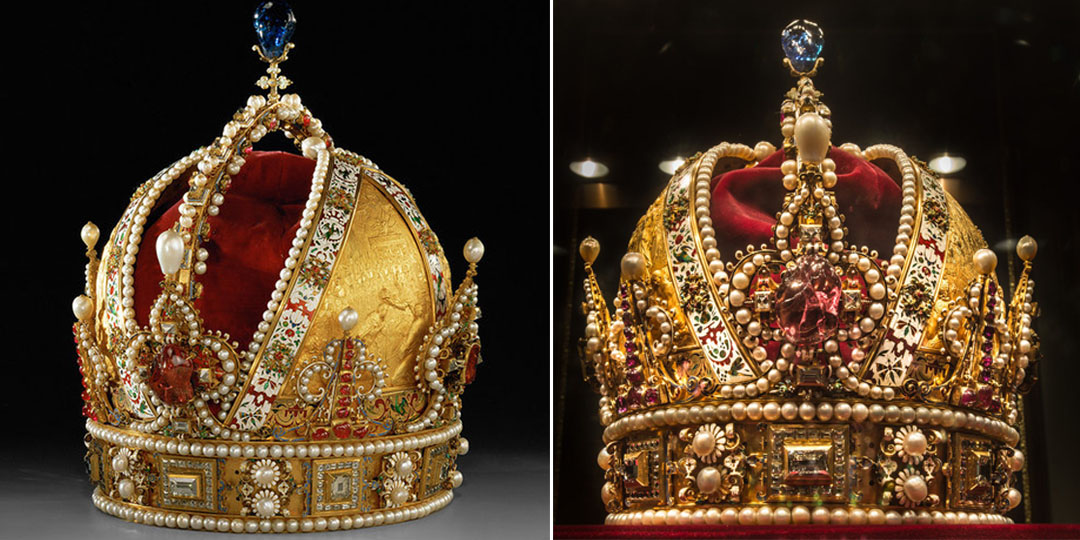
The Imperial Crown of Austria also known as the Crown of Emperor Rudolf II; was made in 1602 in Prague by Jan Vermeyen. It consists of three sections, each possessing a symbolic significance:
1. Circlet: It’s dominated by eight large squares of diamonds along with precious stones such as spinels and zircons. Between the stones are two large pearls arranged vertically and set within white enamel rosettes surrounded by scrollwork.
2. Mitre: Symbolises the divine right to rule and the spiritual position of the emperor. It fills the left and right sides of the crown, leaving an opening in the middle through which the high arch passes. The mitre is divided into four sections representing the high honours of Holy Roman Emperor Rudolf II.

Image 1: Holy Roman Emperor Rudolf II is seen kneeling, receiving the Imperial Crown.
Image 2: Rudolf II is seen riding onto the coronation hill in Pressburg (Bratislava) during his coronation as King of Hungary.
Image 3: This section shows Rudolf II ‘s coronation procession through Prague as King of Bohemia.
Image 4: The fourth section shows his victory over the invading Turks.
3. High Arch: It was inspired by the arch of the Imperial Crown of the Holy Roman Empire. It rises from the front and back of the circlet and is studded with eight diamonds, which symbolise Christ. At the top of the arch is a polished blue-green emerald, which symbolises heaven.
Imperial Orb

The royal orb is a symbol of monarchical power. Since Hellenic times, the globe has served as a sign of sovereign power and the Roman emperors used it as a symbol of their world domination along with the goddess of victory positioned on top.
Imperial Orb was commissioned in 1612 by Rudolf’s brother and successor Holy Roman Emperor Matthias and created by Andreas Ochsenbruck.
It’s inspired by the Imperial Crown has similar enamel detailing and is topped by a large sapphire.
The Sceptre
Sceptre is a staff or wand held in the hand by a ruling monarch as a symbol of royal authority.
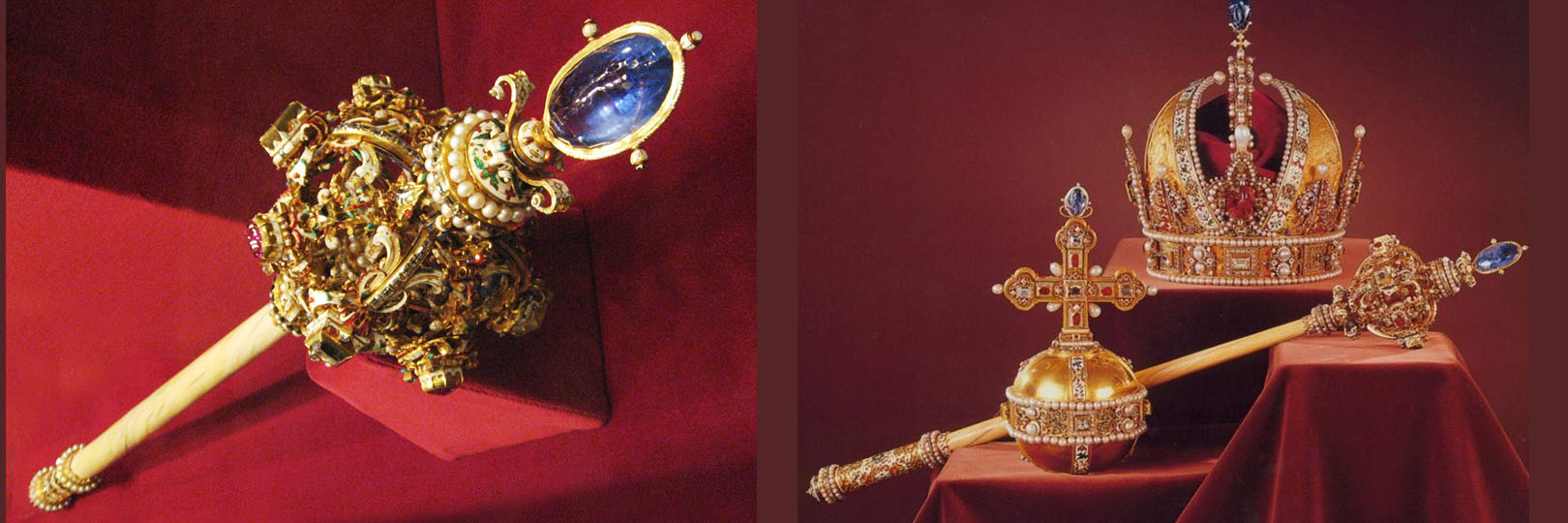
The above Sceptre made from the horn of a narwhal is displayed along with The Imperial Crown and Imperial Orb at the Hofburg Palace in Vienna, Austria. Just like the Imperial Orb, the sceptre also takes its inspiration from the crown, especially the enamel-work which is in the same style. It is also topped by a large sapphire.
Imperial Regalia of the Holy Roman Empire:
It included the Imperial Crown, Imperial Cross, Imperial Sword and the Holy Lance.
The Imperial Crown
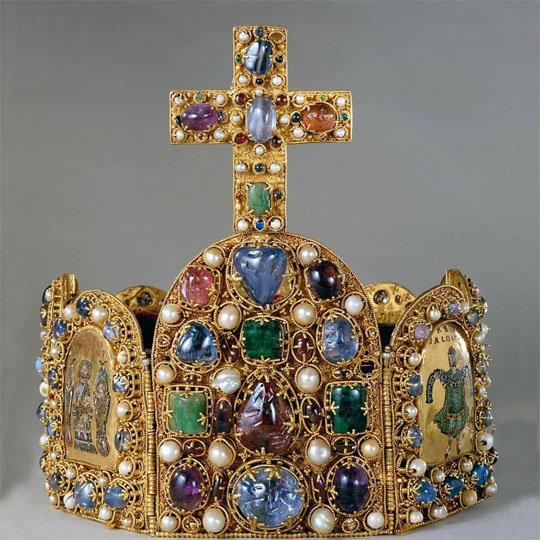
The coronation crown was the most important item of the Imperial Regalia. Its eight hinged plates; made with 22k gold and studded with pearls and precious stones were arched at the top. The smaller four plates have images of figures and scenes from the Bible and the other four plates are decorated with gemstones in raised filigree settings.

Image 1: The Front Right Plate shows Christ in Majesty between two cherubim beneath the inscription in red enamel “By me kings reign” (ME REGES REGNANT)
Image 2: The Back Right Plate shows the Prophet Isaiah standing and speaking to King Hezekiah, who is shown sitting on his bed. Isaiah holds a scroll with the words, “Behold, I will add fifteen years to your life”. Above both Isaiah and Hezekiah are their names in red enamel (ISAIASPHETA · EZECHIAS REX).
Image 3: The Front Left Plate shows King Solomon holding a scroll with the words, “Fear the Lord and flee from evil with his name above in red enamel “King Solomon”
Image 4: The Back Left Plate shows King David holding a scroll with the words, “The renowned king delights in doing justice” beneath the inscription naming him in red enamel (REX DAVID).
The Imperial Cross

The Imperial Cross was created in 1024–25/ 1030 at Lotharingia. It served as the container for the two “Great Relics of Christ.” The Holy Lance in its horizontal arms and the reliquary of the True Cross in the lower shaft. It has an oak core that is coated on the outside with gold leaf and red leather on the inside. The front of the cross is decorated with pearls and gemstones.
The Imperial Sword
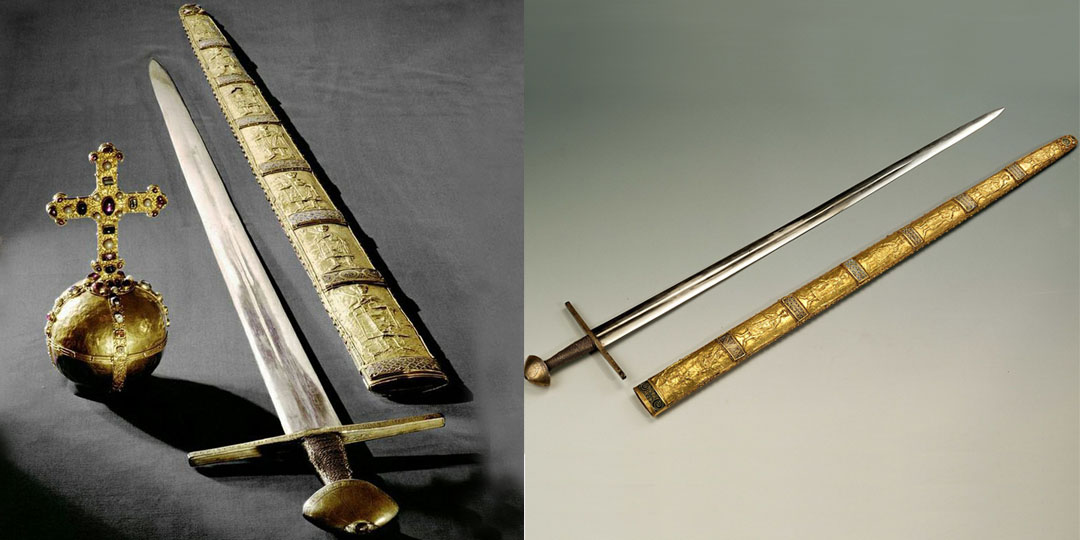
The Imperial Sword is one of the four most important parts of the Imperial Regalia of the Holy Roman Empire. During a coronation, it was given to the emperor along with the Imperial Crown, Imperial Sceptre and the Imperial Orb. All four important parts of the Imperial Regalia are displayed in the Imperial Treasury at the Hofburg Palace in Vienna, Austria.
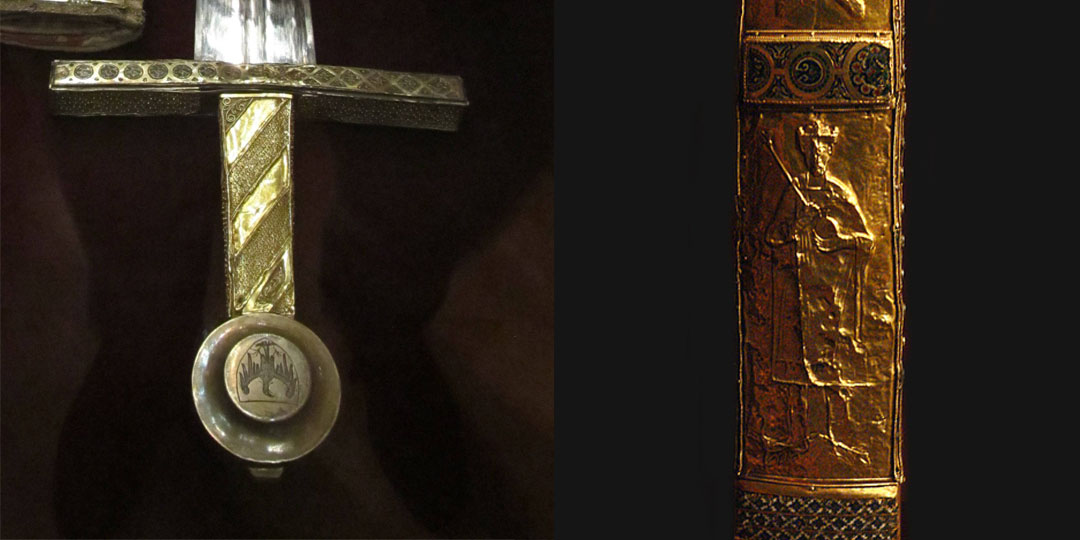
The Sword originated during the high medieval period and was perhaps made for Emperor Otto IV’s coronation as King of the Romans in 1198.
The pommel is of “mushroom” or “tea-cosy” shape and engraved with the arms of Holy Roman Emperor Otto IV, who reigned from 1209 to 1215. The scabbard of the sword is adorned with 14 gold plates, engraved with depictions of monarchs.
Coronation Gloves, Shoes, Hose and Socks.

Gloves: During the coronation of Frederic II, a pair of gloves were made in the early 13th century in Palermo in red silk, gold wire embroidery, pearls, sapphires, rubies and enamelled plaques; accentuated with birds and angels figures. The palms of the gloves have a single-headed eagle in gold thread.

Shoes: The coronation shoes were crafted with embroidery detailing and pearls. They were often reworked due to the varying size of the emperor’s feet.
Hose: This leather Hose became a part of the coronation garb in Palermowere.
Socks: Woven in Magenta-colored silk with gold embroidery along the edge of the socks.
Did you know: The magenta colour could only be used by the emperor.
Well, I certainly wouldn’t mind wearing these ornate basics and sit pretty all day!
Baptismal Ewer and Basin

This gold and enamelled basin was a wedding present of the Carinthian estates to Archduke Charles of Inner Austria and Maria of Bavaria 1571. Though the basin was meant to be used for handwashing at the dining table, the imperial family used the basin for baptisms. Despite not having any religious motifs, this tradition was maintained until the end of the monarchy. The detailing, metalwork and craftsmanship of the historic piece is worth admiration, isn’t it? Let me know in the comments
Cradle of Rome.

I’ll take you through the different qualities of the cradle that makes it so admirable.
1. It was a gift from the city of Paris to Napoléon-François-Charles-Joseph and his second wife, Marie-Louise, on the occasion of the birth of their son, who was bestowed the title of “King of Rome”.
2. Designed with the magnificence of a throne in appx 280 kg of silver, this cradle is one of the finest pieces of imperial furniture, with rich imagery and every detail emphasising the national importance attached to the birth of an heir the throne.
3. Standing on feet fashioned as crossed horns, the boat of the cradle is decorated with mother-of-pearl set on a velvet background with gilt bees.
4. At the head of the cradle, there is a shield bearing the Emperor’s cypher, encircled by palms and laurels.
5. Above is winged Victor, soaring over the world, with a double crown of stars and laurels, from which hang the drapes.
6. At the foot of the cradle, an eaglet is perched, preparing to fly towards a star with Napoleon’s monogram, standing out from the wreath of stars.
7. Two sculptures on the sides of the cradle boat evoke the union of Paris and Rome, the two principal cities of the Empire, linked by the birth of the young king.
8. The cradle came into the possession of the Treasury in 1832 following the death of the former king of Rome.
Order of the Golden Fleece
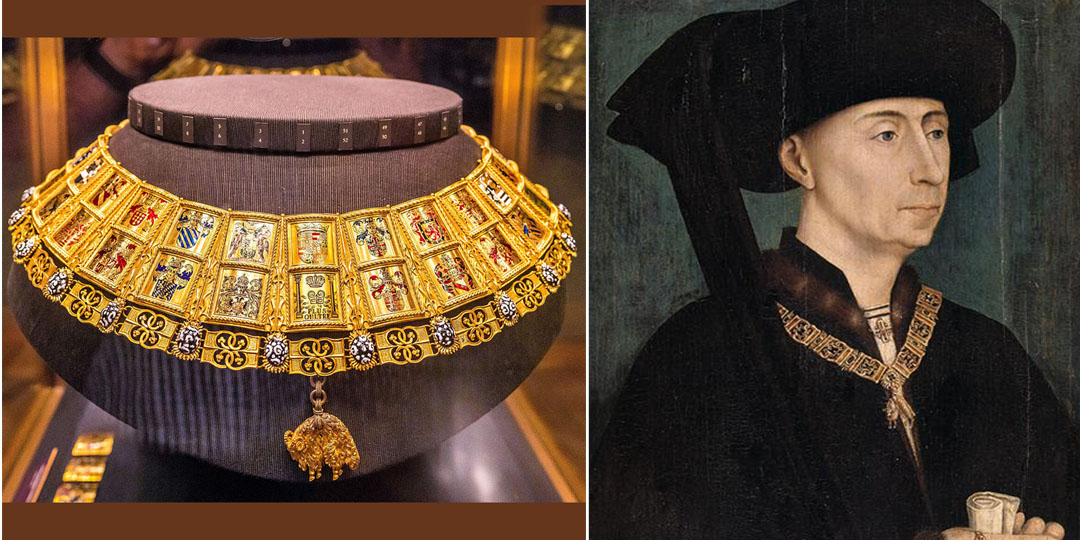
Image 1: Neck Collar is worn by the King of Arms to the Order of the Golden Fleece.
Images 2: Philip III, Duke of Burgundy, with the collar of the order.
It’s a chivalry order founded in 1430 by Philipp III, the Duke of Burgundy. The official objectives of the order have been the preservation of the catholic faith, the protection of the church and the promotion of knightly conduct. Today, there exists two branches of the Order: the Spanish and the Austrian Fleece, the Spanish branch of the order, has been referred to as the most prestigious and historic order of chivalry in the world.
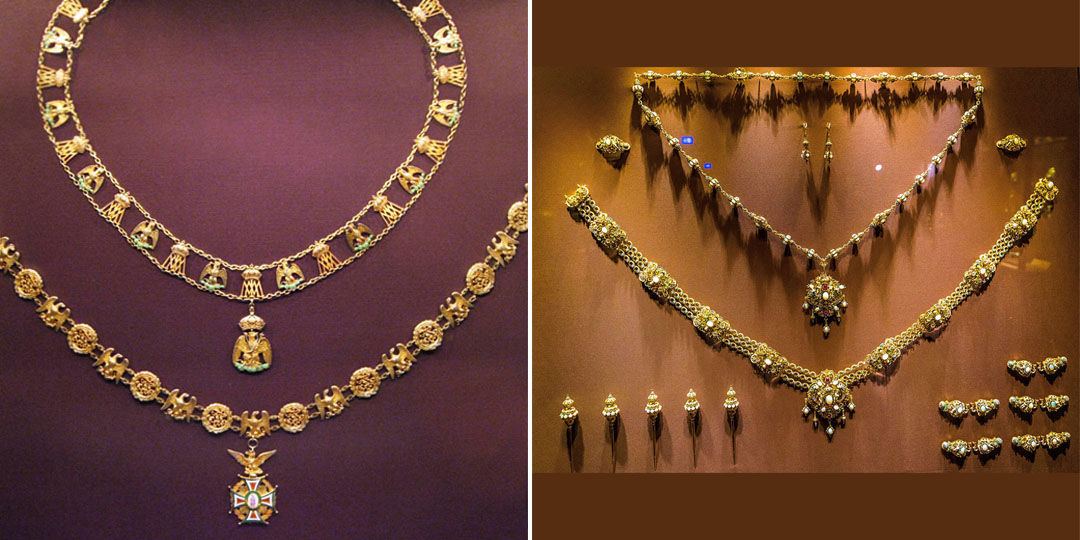
Image 1: Memorabilia of Emperor Maximilian I of Mexico.
Image 2: City of Budapest Opal Suite.
Neck Chain of a Knight of the Order of the Golden Fleece is the only surviving neck chain from the early period of the Order of the Golden Fleece. The chain was awarded by the sovereign and symbolised the fundamental concept of equality and brotherhood among members of a secular order of knights. It consists of a series of loose elements that are linked together.
The Crown of Stephen Bocskai

Stephen Bocskai; the Prince of Hungary and Transylvania received this crown from the Ottoman Sultan in the early 17th century. It’s embellished in gold, rubies, spinels, emeralds, turquoises & pearls.
As we almost approaching the end of the article, I would like to briefly show you a few exhibits almost 1000 years old, displayed in the treasury in beautiful wooden cabinets topped with golden decoration that have a unique historical and religious significance of the Austro-Hungarian Empire.

The Imperial Treasury also has a few exclusive gemstones

Image 1: An Emerald Unguentarium made out of a single piece of 2,680cts emerald and enamelled with gold.
Image 2: Emperor Leopold I acquired this precious stone called “Hyacinth La Bella” a 416cts garnet in 1687 and added a richly enamelled double eagle with the imperial crown, sword and a sceptre holding the arms of Hungary and Bohemia in its claws.
Image 3: The Agate Bowl is the largest carved stone bowl in the world.
A richly faceted 492 cts aquamarine.
Image 4: Hungarian opal, ca. 1600.
Hope you enjoyed the article. The craftsmanship and detailing of jewels dating back to the ancient eras is certainly fascinating!
So, has anyone visited the Imperial Treasury? I would love to hear about your experience! Leave a comment below and let’s discuss.
Credits: Kunsthistorisches Museum, Pratiek Dhadha.
Disclaimer: The above images belong to their respective sources, where rights may be held. Usage here is for information/reference purpose only.
